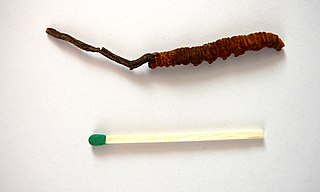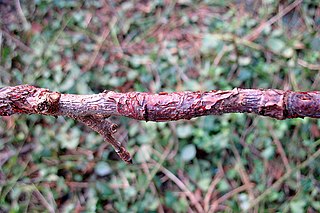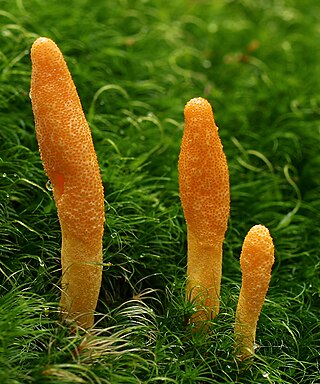Related Research Articles
An ascocarp, or ascoma, is the fruiting body (sporocarp) of an ascomycete phylum fungus. It consists of very tightly interwoven hyphae and millions of embedded asci, each of which typically contains four to eight ascospores. Ascocarps are most commonly bowl-shaped (apothecia) but may take on a spherical or flask-like form that has a pore opening to release spores (perithecia) or no opening (cleistothecia).

Ophiocordyceps sinensis, known colloquially as caterpillar fungus, is an entomopathogenic fungus in the family Ophiocordycipitaceae. It is mainly found in the meadows above 3,500 metres (11,500 ft) on the Tibetan Plateau in Tibet and the Himalayan regions of Bhutan and Nepal. It parasitizes larvae of ghost moths and produces a fruiting body which is valued in traditional Chinese medicine as an aphrodisiac. Caterpillar fungus contains the compound cordycepin, an adenosine derivative. However, the fruiting bodies harvested in nature usually contain high amounts of arsenic and other heavy metals, so they are potentially toxic and sales have been strictly regulated by China's State Administration for Market Regulation since 2016.

The Hypocreales are an order of fungi within the class Sordariomycetes. In 2008, it was estimated that it contained some 237 genera, and 2647 species in seven families. Since then, a considerable number of further taxa have been identified, including an additional family, the Stachybotryaceae. Wijayawardene et al. in 2020 added more families and genera to the order. According to the Catalog of Life, As of April 2021 the Hypocreales contains 6 families, 137 genera, and 1411 species. Hyde et al. (2020a) listed 14 families under Hypocreales, while, Wijayawardene et al. (2022) accepted 15 families in the order, where Cylindriaceae was additionally added. Earlier, Hyde et al. (2020a) had placed Cylindriaceae in class Xylariomycetidae. Samarakoon et al. (2022) agreed. Hence, Cylindriaceae should have been excluded from Hypocreales and placed in Xylariomycetidae. Xiao et al. (2022) recently introduced a new family Polycephalomycetaceae to Hypocreales.

Nectria is a genus of Ascomycete fungi. They are most often encountered as saprophytes on decaying wood but some species can also occur as parasites of trees, especially fruit trees and a number of other hardwood trees. Some species are significant pests causing diseases such as apple canker, Nectria twig blight, and coral spot in orchards.

The Nectriaceae comprise a family of fungi in the order Hypocreales. It was circumscribed by brothers Charles and Louis René Tulasne in 1865. In 2020, an Outline of fungi was produced and listed 70 genera and about 1,336 species.
Phyllostachys heteroclada, the fishscale bamboo, also known as "water bamboo", is a running bamboo. The water bamboo name comes from the air canals in the rhizomes and roots that allow this bamboo to grow in more saturated conditions as compared to similar species. This species can also have abrupt kinks at the base of the culms. Maximum height can reach 35 ft with a diameter of 2 in. It is cold hardy to around -5 °F. It grows well in USDA zones 6b-10.

Hypocreomycetidae is a subclass of sac fungi.

Metarhizium is a genus of entomopathogenic fungi in the Clavicipitaceae family. With the advent of genetic profiling, placing these fungi in proper taxa has now become possible. Most turn out to be the asexual forms (anamorphs) of fungi in the phylum Ascomycota, including Metacordyceps spp.

The Arthoniales is the second largest order of mainly crustose lichens, but fruticose lichens are present as well. The order contains around 1500 species, while the largest order with lichenized fungi, the Lecanorales, contains more than 14000 species.
Myriangium is a genus of fungi within the family Myriangiaceae.
Tubeufia is a genus in the Tubeufiaceae family of fungi.

Purpureocillium is a fungal genus in the Ophiocordycipitaceae family. The genus now contains at least 5 species with the type species Purpureocillium lilacinum, a common soil mold. It has been isolated from a wide range of habitats, including cultivated and uncultivated soils, forests, grassland, deserts, estuarine sediments and sewage sludge, and insects. It has also been found in nematode eggs, and occasionally from females of root-knot and cyst nematodes. In addition, it has frequently been detected in the rhizosphere of many crops. The species can grow at a wide range of temperatures – from 8 to 38 °C for a few isolates, with optimal growth in the range 26 to 30 °C. It also has a wide pH tolerance and can grow on a variety of substrates. P. lilacinum has shown promising results for use as a biocontrol agent to control the growth of destructive root-knot nematodes.

Neonectria is a genus of fungi in the family Nectriaceae.

The Cordycipitaceae are a family of parasitic fungi in the Ascomycota, class Sordariomycetes and order Hypocreales. The family was first published in 1969 by mycologist Hanns Kreisel, but the naming was invalid according to the code of International Code of Nomenclature for algae, fungi, and plants. It was validly published in 2007.

Ophiocordyceps formicarum is an entomopathogenic fungus belonging to the order Hypocreales (Ascomycota) in the family Ophiocordycipitaceae. The fungus was first described by mycologist George S. Kobayashi in 1939 as a species of Cordyceps. Originally found in Japan growing on an adult Hercules ant, it was reported from Guizhou, China, in 2003. It was transferred to the new genus Ophiocordyceps in 2007 when the family Cordycipitaceae was reorganized. A technique has been developed to grow the fungus in an agar growth medium supplemented with yeast extract, inosine, and glucose.
Clonostachys is a genus of fungi in the order Hypocreales and family Bionectriaceae.

Cordyceps gunni is a species of fungus in the family Cordycipitaceae, and is of the genus Cordyceps. It was originally found and recorded by Gunn in Tasmania and named as Sphaeria gunnii and later moved into the Cordyceps genus and renamed Cordyceps gunnii. This fungus and its sisters in the genus Cordyceps are known for growing out of insect bodies. C. gunnii can be found at ground level poking out of caterpillar burrows, attached to a caterpillar's head.

Stilbella is a genus of fungi in the order Hypocreales. The relationship of this taxon to other taxa within the order is unknown, and it has not yet been placed with certainty into any family. It is sometimes placed in the family Bionectriaceae.
Microcera is a genus of Ascomycete fungi in the Nectriaceae family.
Amy Yarnell Rossman is an American mycologist and a leading expert in identifying fungi.
References
- 1 2 3 4 Petch, Studies in entomogenous fungi. The Nectriae parasitic on scale insects. Trans. Brit. Mycol. Soc. 7(3): 146 (1921).
- ↑ Lumbsch TH, Huhndorf SM. (December 2007). "Outline of Ascomycota – 2007". Myconet. Chicago, USA: The Field Museum, Department of Botany. 13: 1–58.
- 1 2 Dao, H.T.; Beattie, G.A.C.; Rossman, A.Y.; Burgess, L.W.; Holford, P. (2016). "Four putative entomopathogenic fungi of armoured scale insects on Citrus in Australia". Mycol. Prog. 15: 47.
- 1 2 3 Xu, Xiu-Lan; Zeng, Qian; Lv, Yi-Cong; Jeewon, Rajesh; Maharachchikumbura, Sajeewa S.N.; Wanasinghe, Dhanushka N.; Hyde, Kevin D.; Xiao, Qian-Gang; Liu, Ying-Gao; Yang, Chun-Lin (2021). "Insight into the Systematics of Novel Entomopathogenic Fungi Associated with Armored Scale Insect, Kuwanaspis howardi (Hemiptera: Diaspididae) in China". J. Fungi. 7 (8): 628. doi: 10.3390/jof7080628 . PMC 8401669 . PMID 34436167.
- 1 2 3 4 Dingley, J.M. (1954). "The Hypocreales of new zealand VI. The genera Hypocrella, Barya, Claviceps and Podonectria". Trans. R. Soc. N. Z. 81: 489–499.
- 1 2 3 4 Rossman, A.Y. (1978). "Podonectria, a genus in the Pleosporales on scale insects". Mycotaxon. 7: 163–182.
- 1 2 Dennis, R.W.G. (1957). "New British fungi". Kew Bull. 12: 399–404.
- ↑ Rossman, A.Y. (1977). "The genus Ophionectria (Euascomycetes, Hypocreales)". Mycologia. 69: 355–391.
- ↑ Pirozynski, K.A. (1977). "Notes on Hyperparasitic Sphaeriales, Hypocreales and 'Hypocreoid Dothideales'". Kew Bull. 31: 595–610.
- ↑ Rossman, A.Y. (1987). The Tubeufiaceae and Similar Loculoascomycetes. Farnham Royal, UK: C.A.B. International. p. 43.
- ↑ Spatafora, J.W.; Quandt, C.A.; Kepler, R.M.; Sung, G.H.; Shrestha, B.; Hywel-Jones, N.L.; Luangsa-ard, J.J. (2015). "New 1F1N species Combinations in Ophiocordycipitaceae (Hypocreales)". IMA Fungus. 6: 357–362.
- ↑ Quandt, C.A.; Kepler, R.M.; Gams, W.; Araújo, J.P.M.; Ban, S.; Evans, H.C.; Hughes, D.; Humber, R.; Hywel-Jones, N.; Li, Z.Z.; Luangsa-Ard, J.J. (2014). "Phylogenetic-based nomenclatural proposals for Ophiocordycipitaceae (Hypocreales) with new combinations in Tolypocladium". IMA Fungus. 5: 121–134.
- ↑ Yang, C.L.; Xu, X.L.; Liu, Y.G. (2019). "Podonectria sichuanensis, a potentially mycopathogenic fungus from Sichuan Province in China". Phytotaxa. 402: 219–231.
- 1 2 "Species Fungorum - Search Page - Podonectria". www.speciesfungorum.org. Retrieved 11 August 2023.